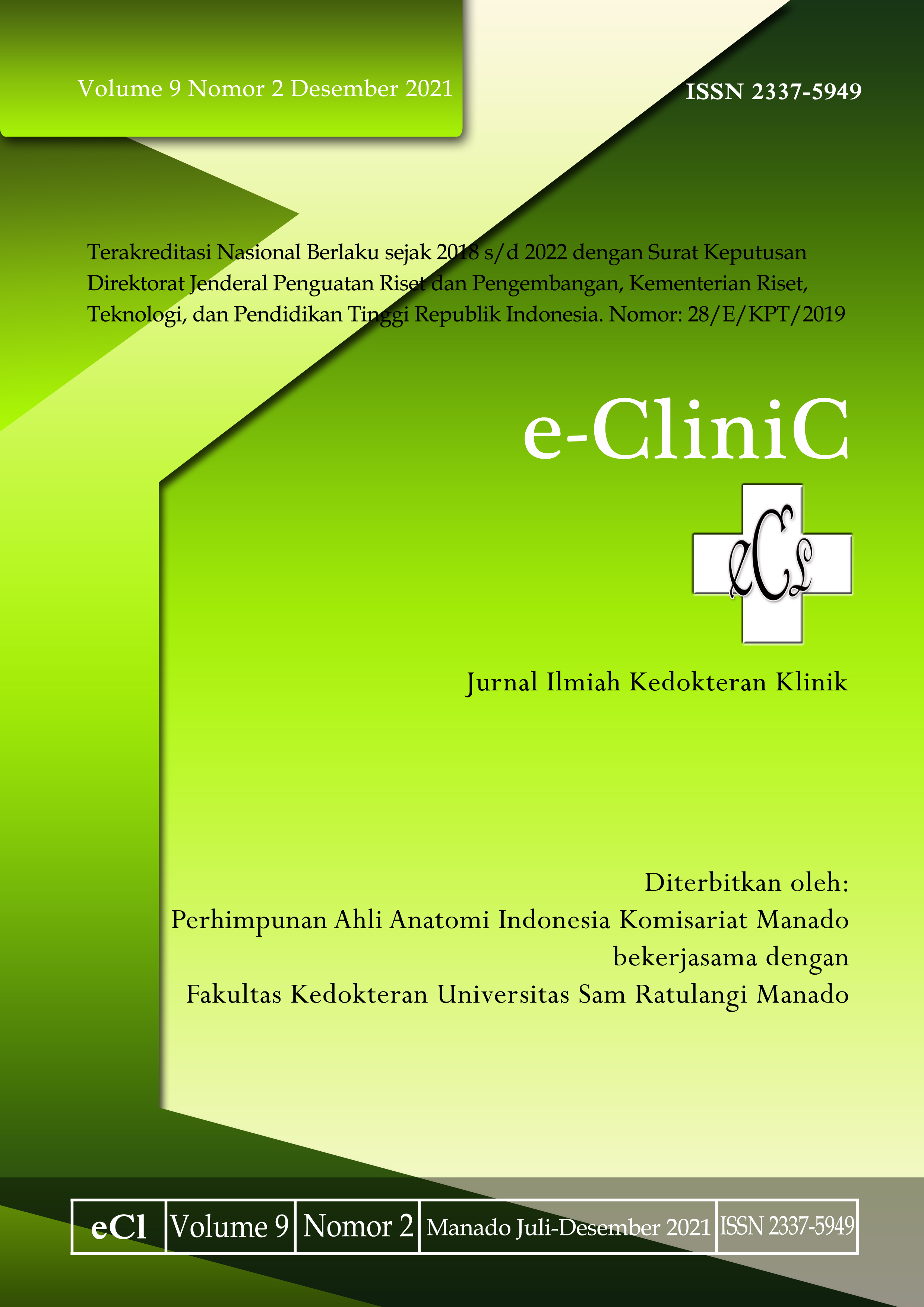Graft Tulang Alveolar dan Pemberian Terapi Oksigen Hiperbarik pada Gnatoschizis: Laporan Kasus
DOI:
https://doi.org/10.35790/ecl.v9i2.36877Abstract
Abstract: Gnatoschizis is a congenital disorder due to complex causes involving many genetic and environmental factors. The shape and complexity of the cleft varies greatly, which will determine the final outcome of the reconstruction. The management involves a multidisciplinary approach including orthodontics, prosthodontics, as well as speech and psychological therapist. Bone grafting materials such as iliac crest (corticocancellous autogenous), bone morphogenetic proteins and recombinant human proteins have shown good long-term results. An additional method that is considered effective in accelerating bone growth is the administration of hyperbaric oxygen therapy (HBOT) which has been reported to increase the accumulation of minerals needed for osteogenesis, such as calcium, magnesium, and phosphorous. We reported a case of a 14-year-old girl with gnatoschizis who underwent an alveolar bone graft surgery and one day after the operation was immediately followed by administration of (HBOT) to improve the bone healing process. cleft location. Autogenous iliac bone graft was used for closure of the bony defect at the site of the cleft. Follow up at day-14 showed a satisfying result. In conclusion, in this patient continuity of upper dental arch was achieved as well as optimal alar basis, no fistula, stabile upper dental arch for orthodontic treatment, and ideal alveolar morphology that supported the ultimate goal of cleft palate treatment - improvement of quality of life.
Keywords: gnatoschizis; alveolar bone graft; hyperbaric oxygen therapy
 Â
Abstrak: Gnatoschizis merupakan kelainan kongenital dengan penyebab kompleks yang meli-batkan banyak faktor genetik dan lingkungan. Bentuk dan kompleksitas sumbing sangat bervariasi, yang akan menentukan hasil akhir rekonstruksi. Tatalaksananya melibatkan pendekatan multi-disiplin termasuk ortodontik, prostodontik, serta terapi wicara dan psikologis. Bahan pencang-kokan tulang seperti krista iliaka (corticocancellous autogenous), protein morfogenetik tulang dan protein manusia rekombinan telah menunjukkan hasil jangka panjang yang baik. Salah satu metode tambahan yang dianggap efektif mempercepat pertumbuhan tulang ialah pemberian terapi oksigen hiperbarik (TOHB) yang telah dilaporkan meningkatkan akumulasi mineral yang dibutuh-kan untuk osteogenesis, seperti kalsium, magnesium, dan fosfor. Kami melaporkan kasus seorang anak perempuan berusia 14 tahun dengan gnatoschizis yang menjalani operasi cangkok tulang alveolar dan satu hari setelah operasi langsung dilanjutkan pemberian TOHB untuk meningkatkan proses penyembuhan tulang. Cangkok tulang iliaka autogenous digunakan untuk penutupan defek tulang di lokasi sumbing. Follow up pada hari ke 14 di poliklinik dengan pemeriksaan fisik pada defek lokasi sumbing mendapatkan hasil yang memuaskan. Simpulan laporan kasus ialah pada pasien ini diperoleh kontinuitas lengkung rahang atas, basis alar yang optimal, fistula dihilangkan, segmen rahang atas yang stabil untuk perawatan ortodontik, dan morfologi alveolar yang ideal yang menyokong tujuan akhir tatalaksana sumbing yaitu perbaikan kualitas hidup.
Kata kunci: gnatoschizis; cangkok tulang alveolar; terapi oksigen hiperbarik
Downloads
Published
How to Cite
Issue
Section
License
COPYRIGHT
Authors who publish with this journal agree to the following terms:
Authors hold their copyright and grant this journal the privilege of first publication, with the work simultaneously licensed under a Creative Commons Attribution License that permits others to impart the work with an acknowledgment of the work's origin and initial publication by this journal.
Authors can enter into separate or additional contractual arrangements for the non-exclusive distribution of the journal's published version of the work (for example, post it to an institutional repository or publish it in a book), with an acknowledgment of its underlying publication in this journal.
Authors are permitted and encouraged to post their work online (for example, in institutional repositories or on their website) as it can lead to productive exchanges, as well as earlier and greater citation of the published work (See The Effect of Open Access).







